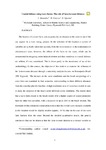Coastal defence using wave farms: The role of farm-to-coast distance
| dc.contributor.author | Abanades, J | |
| dc.contributor.author | Greaves, Deborah | |
| dc.contributor.author | Iglesias, Gregorio | |
| dc.date.accessioned | 2016-04-28T14:48:59Z | |
| dc.date.available | 2016-04-28T14:48:59Z | |
| dc.date.issued | 2015 | |
| dc.identifier.issn | 0960-1481 | |
| dc.identifier.issn | 1879-0682 | |
| dc.identifier.uri | http://hdl.handle.net/10026.1/4555 | |
| dc.description.abstract |
The location of a wave farm and, in particular, its distance to the coast is one of the key aspects in a wave energy project. The effects of the farm on the coast, which can be instrumental in mitigating storm-induced erosion and thus contribute to coastal defence, are sometimes disregarded in selecting its location, possibly due to the inexistence of an ad hoc methodology. In this context, the objective of this work is to examine the influence of the farm-to-coast distance through a sensitivity analysis in a case study: Perranporth (UK). The impacts of a wave farm on the beach morphology are examined in four scenarios with different farm-to-coast distances using a high-resolution suite of numerical models. The results show that a wave farm closest to the beach offers the highest degree of coastal protection (up to 20% of beach erosion reduction). The downside of this enhanced coastal protection is that the wave resource available at this location would be slightly smaller (approx. 10%) than in the case of the wave farms further from the coast. More generally, we find that the farm-to-coast distance is a critical variable in determining the effectiveness of a wave farm for coastal defence. | |
| dc.format.extent | 572-582 | |
| dc.format.medium | 0 | |
| dc.language | en | |
| dc.language.iso | en | |
| dc.publisher | Elsevier BV | |
| dc.subject | Wave energy | |
| dc.subject | Wave farm | |
| dc.subject | Nearshore impact | |
| dc.subject | Beach morphology | |
| dc.subject | Erosion | |
| dc.subject | Sediment transport | |
| dc.title | Coastal defence using wave farms: The role of farm-to-coast distance | |
| dc.type | journal-article | |
| dc.type | JOUR | |
| plymouth.author-url | http://www.sciencedirect.com/science/article/pii/S0960148114006752 | |
| plymouth.volume | 75 | |
| plymouth.publication-status | Published | |
| plymouth.journal | Renewable Energy | |
| dc.identifier.doi | 10.1016/j.renene.2014.10.048 | |
| plymouth.organisational-group | /Plymouth | |
| plymouth.organisational-group | /Plymouth/Faculty of Science and Engineering | |
| plymouth.organisational-group | /Plymouth/Faculty of Science and Engineering/School of Engineering, Computing and Mathematics | |
| plymouth.organisational-group | /Plymouth/PRIMaRE Publications | |
| plymouth.organisational-group | /Plymouth/REF 2021 Researchers by UoA | |
| plymouth.organisational-group | /Plymouth/REF 2021 Researchers by UoA/UoA12 Engineering | |
| plymouth.organisational-group | /Plymouth/Research Groups | |
| plymouth.organisational-group | /Plymouth/Research Groups/Marine Institute | |
| plymouth.organisational-group | /Plymouth/Users by role | |
| plymouth.organisational-group | /Plymouth/Users by role/Academics | |
| plymouth.organisational-group | /Plymouth/Users by role/Researchers in ResearchFish submission | |
| dc.rights.embargodate | 2015-07-01 | |
| dc.identifier.eissn | 1879-0682 | |
| dc.rights.embargoperiod | 6 months | |
| rioxxterms.versionofrecord | 10.1016/j.renene.2014.10.048 | |
| rioxxterms.licenseref.uri | http://www.rioxx.net/licenses/under-embargo-all-rights-reserved | |
| rioxxterms.type | Journal Article/Review |


